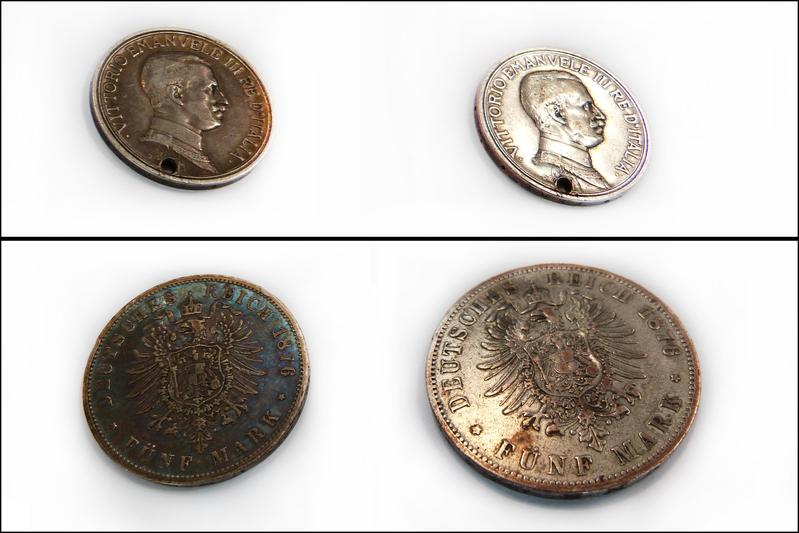

Coins before and after plasma treatment at Fraunhofer FEP
© Fraunhofer FEP, Picture in printable resolution: www.fep.fraunhofer.de/press
Picasso once said: “Art washes away from the soul the dust of everyday life”. But in the course of centuries even art itself, historic valuable objects or cultural assets lose their gloss, “collect dust” or change their appearance by influences of the environment, pollution, humidity or inappropriate storing. Due to the heavy increase in mass tourism the contaminant loads are increasing, which is endangering cultural assets more than ever in history.
For preserving these contemporary witnesses and cultural assets, the Fraunhofer- Gesellschaft has committed to protect and maintain our cultural heritage. Several institutes are systematically researching and developing new technologies for this task. Fraunhofer FEP has been part of the Research Alliance Cultural Heritage (www.forschungsallianzkulturerbe.de/) for years and is using for example electron beam technology for treating historical objects made of silver.
Frank-Holm Rögner, head of the department electron beam processes at Fraunhofer FEP, explains: “We are using electron beam induced plasmas for cleaning historical objects made of silver which went black. They are treated in a reducing atmosphere with accelerated electrons. Thus, the silver sulfide, which is the black film on the objects, is reduced.”
The advantage of this method is that historical objects can be treated without using wet chemistry or abrasive methods. This minimizes the strain of these usually fragile objects, and further side effects like scratches or damages can be avoided.
Thanks to constantly new developed technologies, historical objects like old silver ware or coin collections may be restored to their former glory. The plants at Fraunhofer FEP form a broad basis for treating such impure objects and for developing further cleaning methods.
Furthermore, scientists of Fraunhofer FEP developed technologies for preventing the aggravation of existing damages or for protecting already cleaned historical objects of new damages. Already five years ago the corrosion sensor “AirCorr” was developed together with European partners. “AirCorr” detects very sensitively the potentially existing corrosive gases in the surrounding air and determines in real time the impact on historical objects.
These sensor units are battery-operated and can be placed easily next to the work of art. Thanks to their real time data, they permit a quick reaction to a change in the exhibition or transport environment. The sensor devices were developed and applied for commercial use by a consortium of representatives of research institutes, museums and the industry within the scope of the European research Project »MUSECORR – Protection of cultural heritage by real-time corrosion monitoring« (FP7/2007-2013, FKZ 226539).
The topics cleanness of surfaces as well as cultural heritage play an important role in all research areas and business units at Fraunhofer FEP. For the treatment of many different surfaces and for coatings, suitably prepared surfaces are an essential prerequisite for achieving outstanding functional results. Be it the treatment of flexible foils which will be coated with organic electrodes afterwards, precision coating on optics, or the production of high barrier layer systems – even smallest impurities like particles, fibers, or films can affect or even damage completely the desired layer or functionality.
Furthermore, technologies for generating clean surfaces are a broad area of research at Fraunhofer FEP. The whole range of electron beam and plasma technologies is used to produce pure photocatalytic effective, antibacterial, or cleaning facilitative surfaces which are applied in different areas such as medical engineering, the packaging industry, pharmaceutical industry or precision optics.
The “Industry Partners Day” of Fraunhofer FEP addresses a different research area every year. This year’s event on 27th of September focuses on “Clean Surfaces”. The networking platform offers all interested partners, companies and institutions insights into the topic and encourages discussions for the 5th time now. The whole day long, talks will be given by partners from industry or research and scientists from the institute. Expected talks include topics related to food and packaging technology as well as medical engineering.
The 5th Industry Partners Day is framed by an industry exhibition and a guided tour through our laboratories (electron beam treatment, biomedical laboratory, roll-to-roll inspection system for the processing of OLEDs). The registration form, the current program and further information can be found on the event website.
Press contact:
Mrs. Annett Arnold
Fraunhofer Institute for Organic Electronics, Electron Beam and Plasma Technology FEP
Phone +49 351 2586 333 | presse@fep.fraunhofer.de
Winterbergstraße 28 | 01277 Dresden | Germany | www.fep.fraunhofer.de












